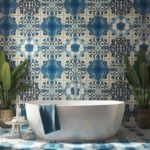Home »
Decorations »
Blue and White Bathroom Tiles: Timeless Elegance in Modern Design
Blue and White Bathroom Tiles: Timeless Elegance in Modern Design
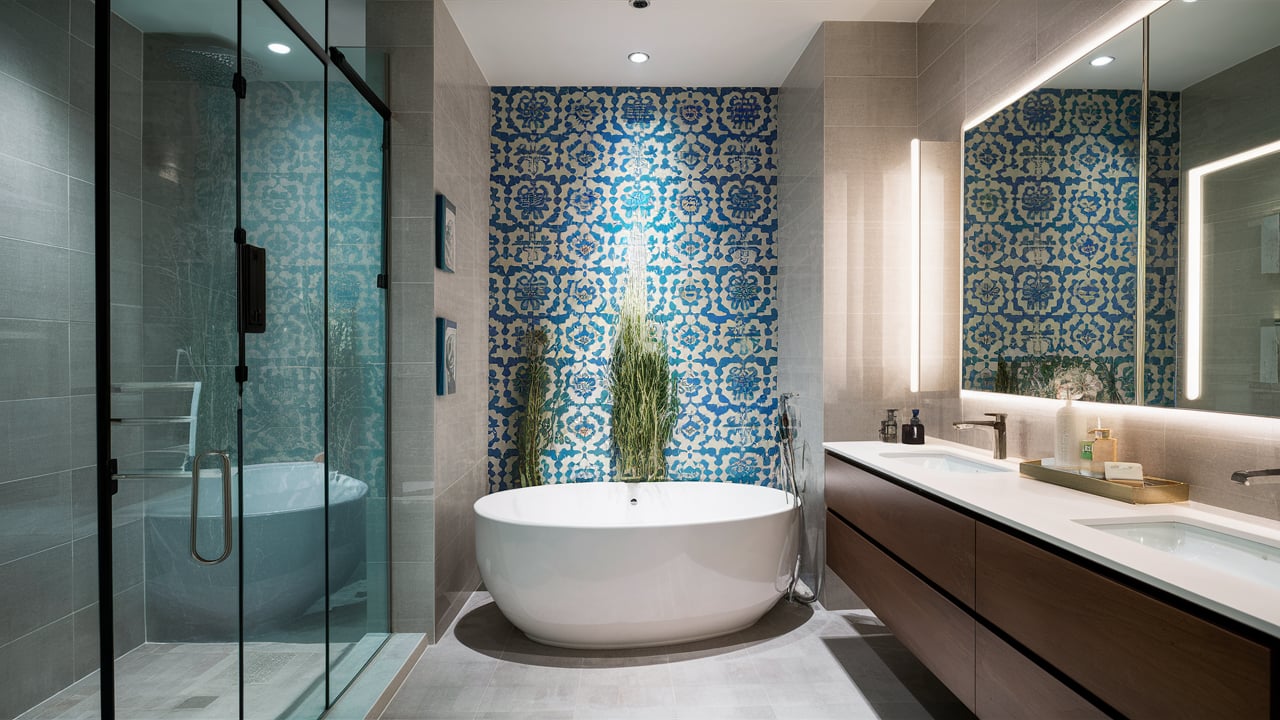
Blue and white bathroom tiles are a classic choice that brings a sense of calm and elegance to any bathroom. This color combination has been cherished for centuries and remains a popular choice due to its timeless appeal and versatility. Whether used in traditional or modern settings, blue and white tiles can transform a bathroom into a serene sanctuary.
In the world of interior design, bathroom aesthetics play a crucial role in the overall ambiance of a home. Blue and white tiles are particularly significant as they can create a soothing environment while adding a touch of sophistication. The color blue is associated with tranquility and peace, making it an ideal choice for spaces intended for relaxation, such as bathrooms.
Historical Context
- Evolution of Bathroom Tiles
The use of tiles in bathrooms dates back to ancient civilizations, where they were prized for their durability and decorative potential. Over the centuries, tile designs have evolved, incorporating various patterns, colors, and materials. The blue and white color scheme has its roots in classic European designs, particularly in Delftware from the Netherlands and traditional Chinese porcelain.
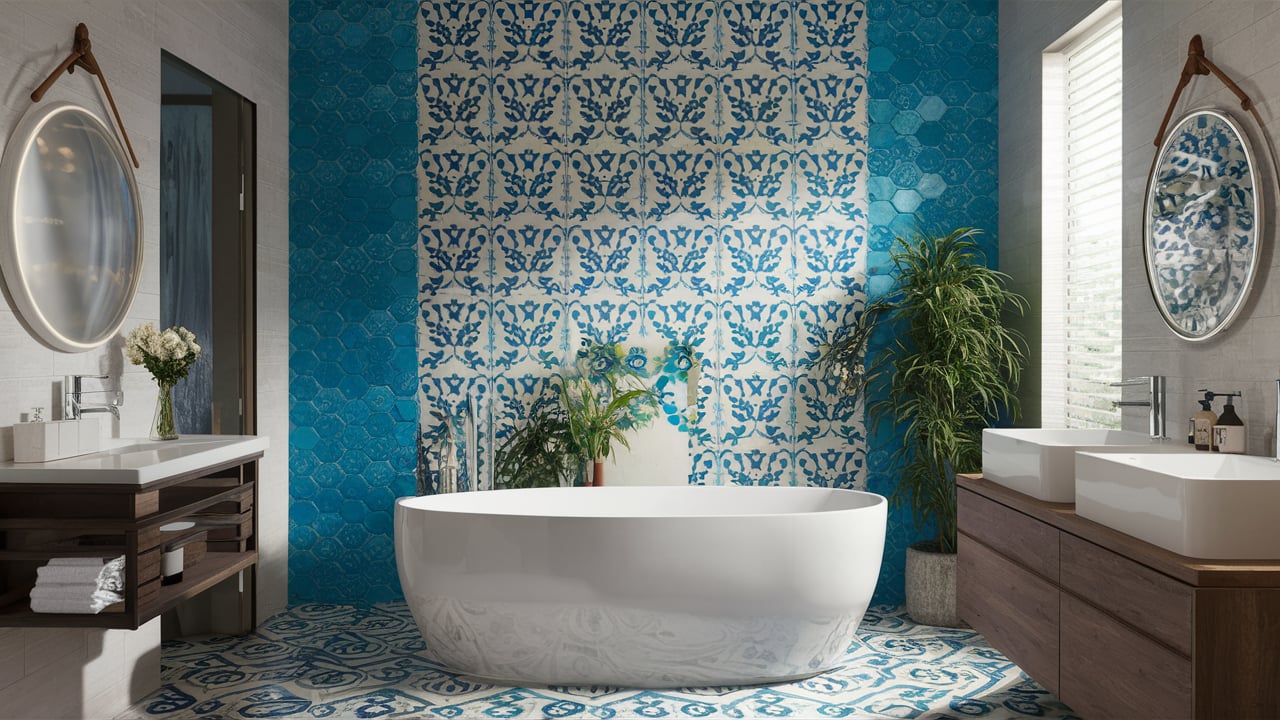
- Influence of Historical Design Trends
Historical design trends have greatly influenced the popularity of blue and white tiles. The Victorian era, known for its ornate and decorative interiors, saw a surge in the use of patterned tiles, including blue and white combinations. These tiles were often used in grand homes and public buildings, adding to their association with elegance and luxury.
Types of Blue and White Bathroom Tiles
- Ceramic Tiles
Ceramic tiles are a popular choice for bathroom surfaces due to their affordability and wide range of designs. They are made from natural clay and can be glazed for a glossy finish or left unglazed for a more rustic look.
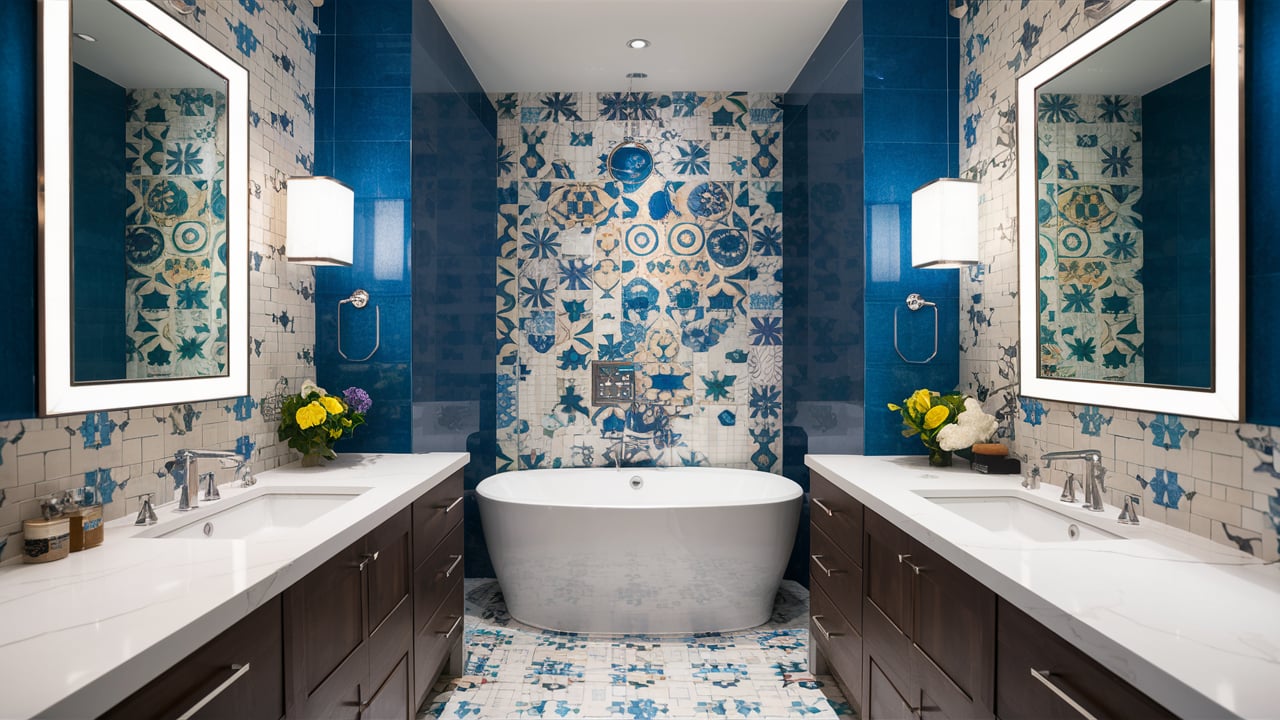
- Porcelain Tiles
Porcelain tiles are known for their durability and water resistance, making them ideal for bathroom applications. They are denser than ceramic tiles and come in a variety of designs, including blue and white patterns that mimic natural stone.
- Glass Tiles
Glass tiles offer a sleek and modern aesthetic. They reflect light beautifully, adding brightness and a sense of space to small bathrooms. Blue and white glass tiles can create stunning mosaics and accent walls.
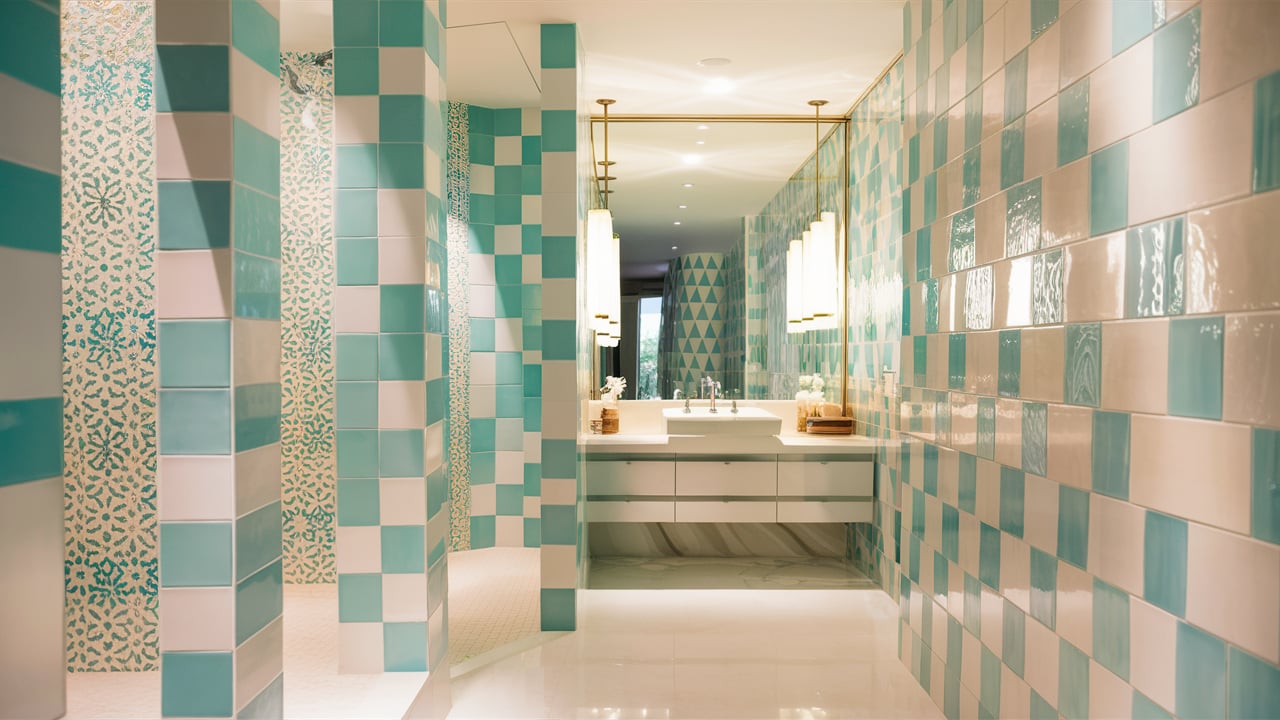
- Mosaic Tiles
Mosaic tiles are small pieces of tile arranged in patterns or images. They can be made from ceramic, glass, or natural stone and are often used to create intricate designs in blue and white.
- Natural Stone Tiles
Natural stone tiles, such as marble and travertine, provide a luxurious and timeless look. Blue and white stone tiles can add a touch of opulence to any bathroom, though they require more maintenance than ceramic or porcelain.
Design Principles
- Color Theory and Its Impact
Color theory plays a significant role in interior design. Blue is often associated with calmness and serenity, while white represents purity and cleanliness. Together, they create a balanced and harmonious environment, perfect for a bathroom setting.
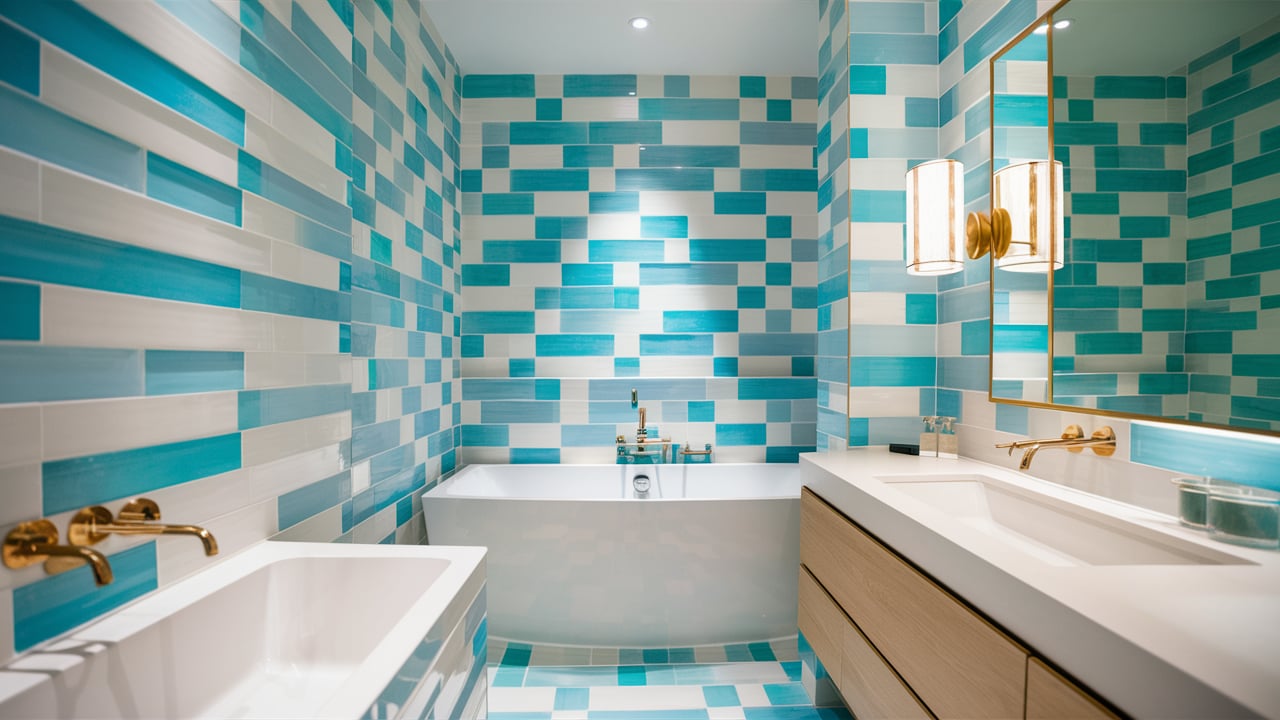
- Patterns and Layouts
Patterns and layouts can greatly influence the overall look of a bathroom. Common patterns for blue and white tiles include herringbone, chevron, and basketweave. Layouts can vary from simple straight patterns to more complex designs that create a focal point in the room.
- Mixing and Matching with Other Colors
While blue and white are a classic combination, they can be complemented by other colors to add depth and interest. Shades of grey, black, and even gold can enhance the overall design, creating a more dynamic and personalized space.
Applications in Different Bathroom Styles
- Classic/Traditional Bathrooms
In classic or traditional bathrooms, blue and white tiles can be used to create a timeless and elegant look. Floral patterns, damask designs, and Victorian-inspired motifs are popular choices.
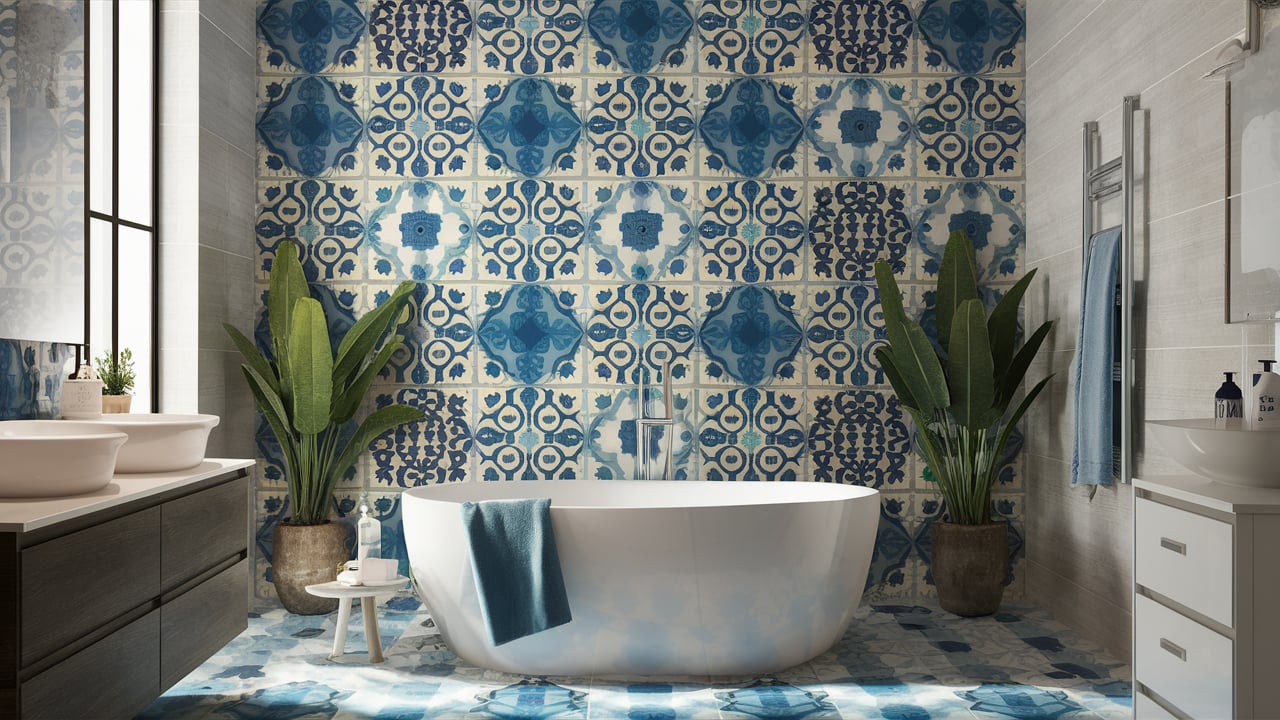
- Modern/Contemporary Bathrooms
For modern or contemporary bathrooms, sleek and minimalist blue and white tiles can be used. Simple geometric patterns and clean lines are key elements in achieving this style.
- Coastal-Themed Bathrooms
Blue and white are quintessential colors for coastal-themed bathrooms. Nautical patterns, sea-inspired motifs, and the use of natural materials like wood and stone can create a relaxing beach-like atmosphere.

- Vintage/Retro Bathrooms
In vintage or retro bathrooms, blue and white tiles can be used to evoke a sense of nostalgia. Subway tiles, checkerboard patterns, and retro floral designs can bring a touch of the past to modern bathrooms.
- Minimalist Bathrooms
Minimalist bathrooms benefit from the simplicity and cleanliness of blue and white tiles. A monochromatic approach with subtle patterns can create a serene and uncluttered space.
Benefits of Blue and White Bathroom Tiles
- Aesthetic Appeal
Blue and white tiles offer a timeless aesthetic that can enhance the beauty of any bathroom. Their classic appeal ensures that they will remain stylish for years to come.
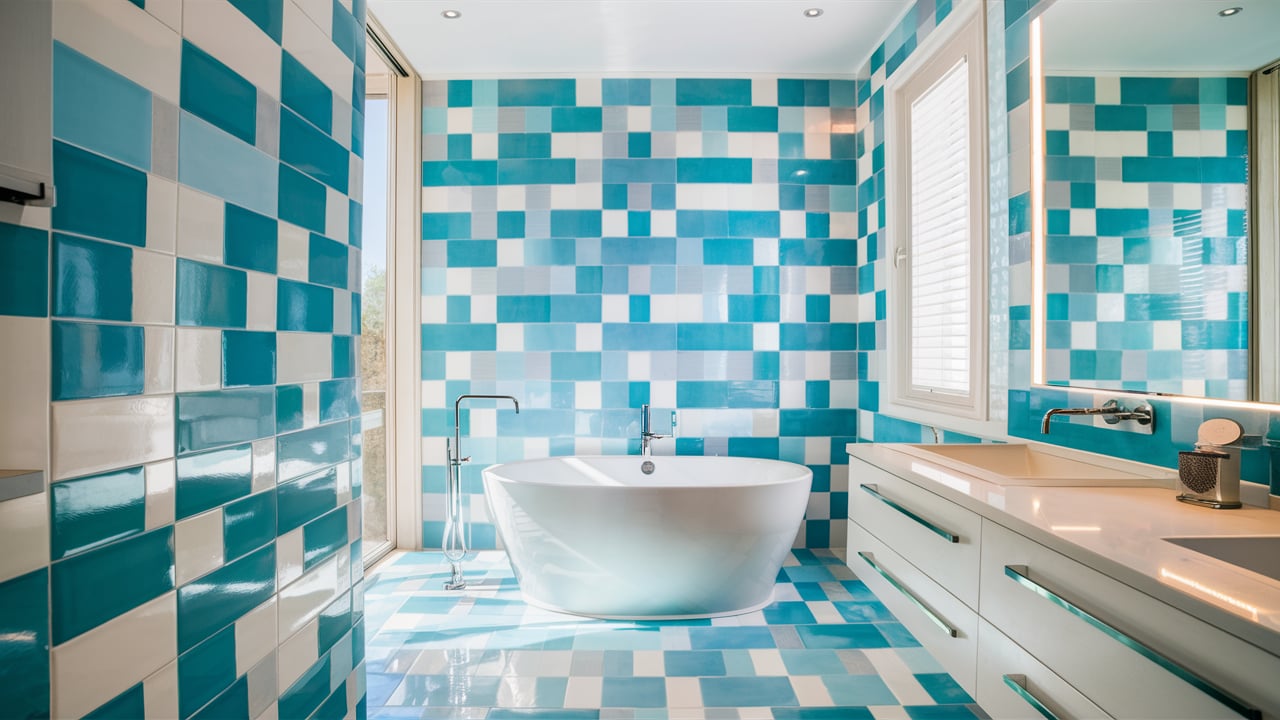
- Versatility in Design
The versatility of blue and white tiles allows them to be used in various design styles, from traditional to modern. They can be adapted to suit any aesthetic preference or theme.
- Durability and Maintenance
Tiles, especially ceramic and porcelain, are known for their durability and ease of maintenance. Blue and white tiles are no exception, providing a long-lasting and low-maintenance option for bathrooms.
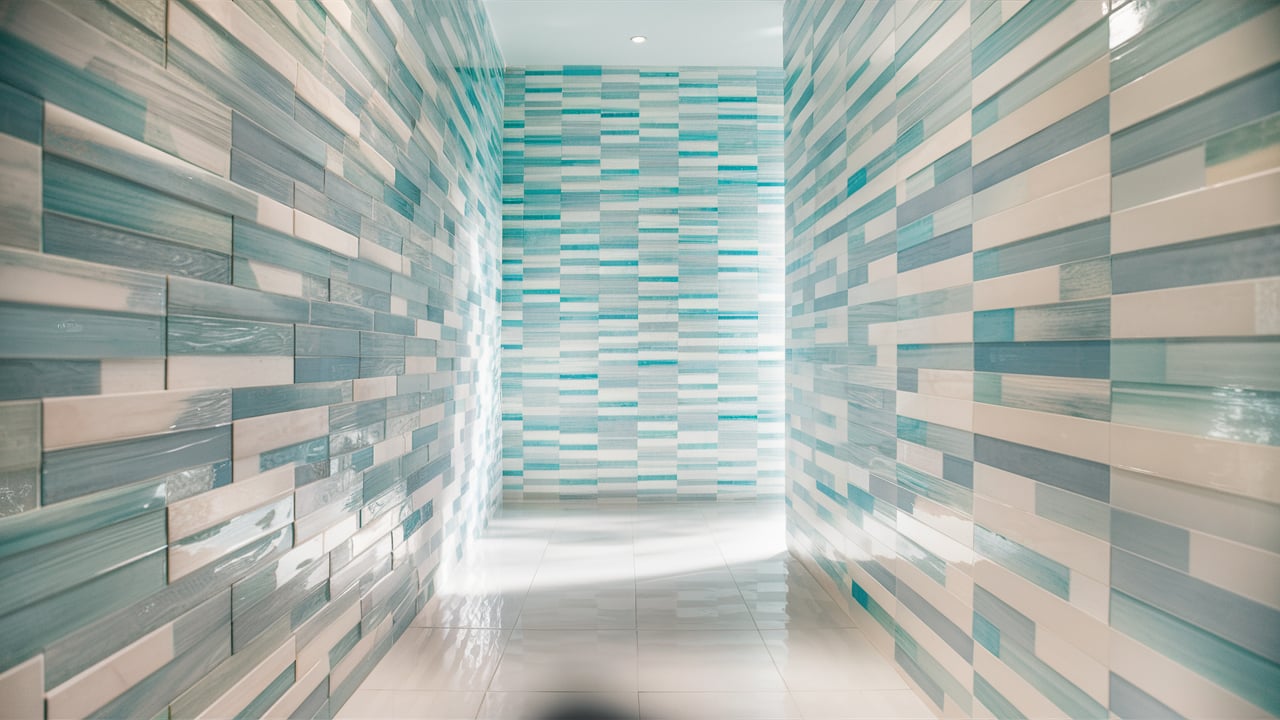
- Cost-Effectiveness
Compared to other materials, tiles are relatively affordable. Blue and white ceramic and porcelain tiles, in particular, offer a cost-effective way to achieve a high-end look without breaking the bank.
Challenges and Solutions
- Common Design Challenges
Designing with blue and white tiles can present challenges, such as ensuring the colors don’t overwhelm the space or clash with other design elements.
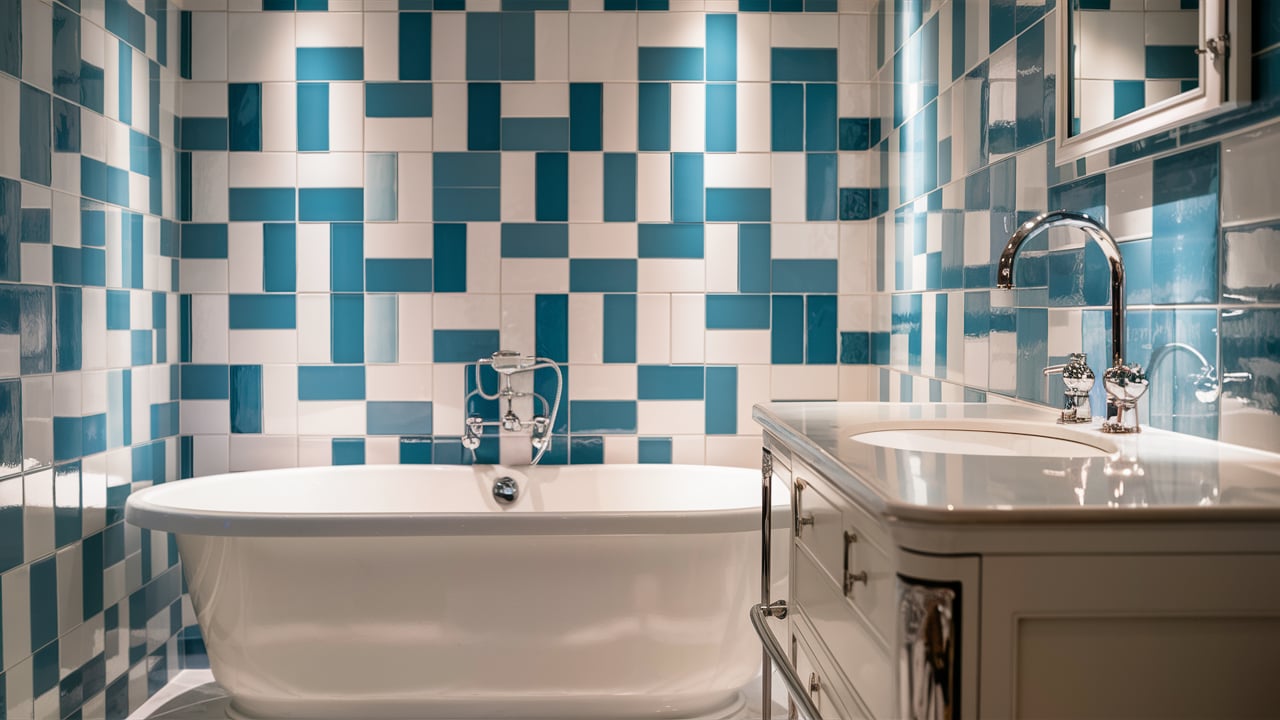
- Solutions and Tips to Overcome Them
To overcome these challenges, it’s important to balance the use of blue and white with neutral tones and natural materials. Using blue and white tiles as accents rather than covering entire walls can also help maintain a balanced look.
Technical Specifications
- Material Properties
Understanding the material properties of blue and white tiles is crucial for making informed decisions. Ceramic and porcelain are durable and water-resistant, while glass offers a modern aesthetic and natural stone provides a luxurious finish.

- Size and Thickness Options
Blue and white tiles come in various sizes and thicknesses, allowing for customization in design. Common sizes include 4×4, 6×6, and subway tiles, while thickness can range from 6mm to 12mm.
- Surface Finishes
Surface finishes can vary from glossy to matte. Glossy finishes reflect light and are easier to clean, while matte finishes provide a more subdued and elegant look.
Installation Guide
- Tools and Materials Needed
For installing blue and white tiles, you’ll need tools such as a tile cutter, trowel, spacers, level, and grout. Materials include adhesive, grout, and sealant.

- Step-by-Step Installation Process
- Preparation: Ensure the surface is clean, dry, and level.
- Layout: Plan the tile layout and mark reference lines.
- Adhesive Application: Apply adhesive to a small area using a trowel.
- Tile Placement: Place tiles according to the layout, using spacers for even spacing.
- Cutting Tiles: Cut tiles to fit edges and corners as needed.
- Grouting: Once the adhesive is set, apply grout between the tiles.
- Sealing: Seal the grout to prevent moisture and stains.
- Tips for a Professional Finish
To achieve a professional finish, ensure even spacing, use a level to keep tiles straight, and clean excess grout promptly.
Maintenance and Care
- Cleaning Routines
Regular cleaning is essential to maintain the appearance of blue and white tiles. Use mild cleaning solutions and avoid abrasive materials that can scratch the surface.

- Preventing and Addressing Mold and Mildew
Mold and mildew can be prevented by ensuring proper ventilation in the bathroom. Regular cleaning and sealing of grout lines also help prevent mold growth.
- Long-Term Care Tips
For long-term care, avoid using harsh chemicals and clean up spills promptly. Re-sealing grout lines periodically will help maintain their integrity and appearance.
Latest Trends in Blue and White Bathroom Tiles
- Current Design Trends
Current trends in blue and white bathroom tiles include geometric patterns, large format tiles, and the use of mixed materials like glass and metal.
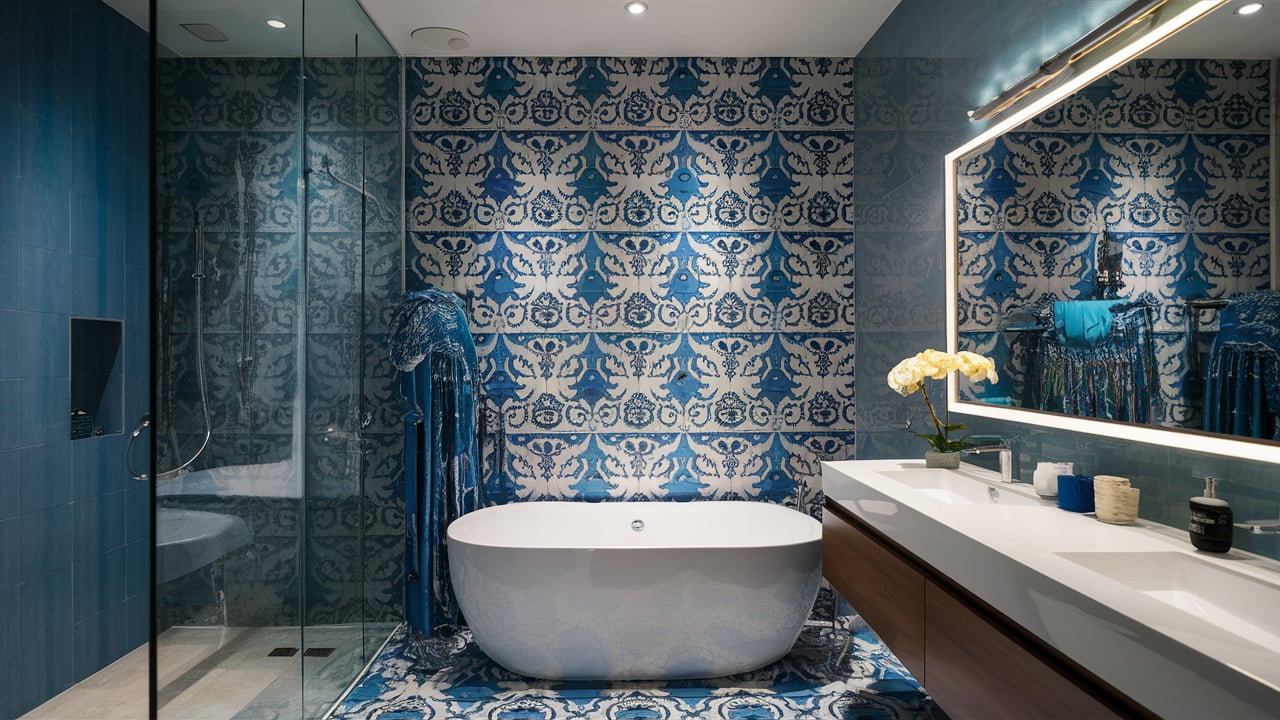
- Innovations in Tile Technology
Innovations in tile technology have led to the development of more durable and eco-friendly tiles. Digital printing techniques allow for intricate designs and realistic textures.
- Popular Patterns and Styles
Popular patterns and styles include herringbone, chevron, and Moroccan-inspired designs. These patterns add visual interest and can create a focal point in the bathroom.
Case Studies and Inspirations
- Real-Life Examples of Blue and White Bathroom Designs
Real-life examples can provide inspiration for your bathroom design. From classic Victorian bathrooms to modern minimalist spaces, blue and white tiles can be used in various ways to create stunning results.
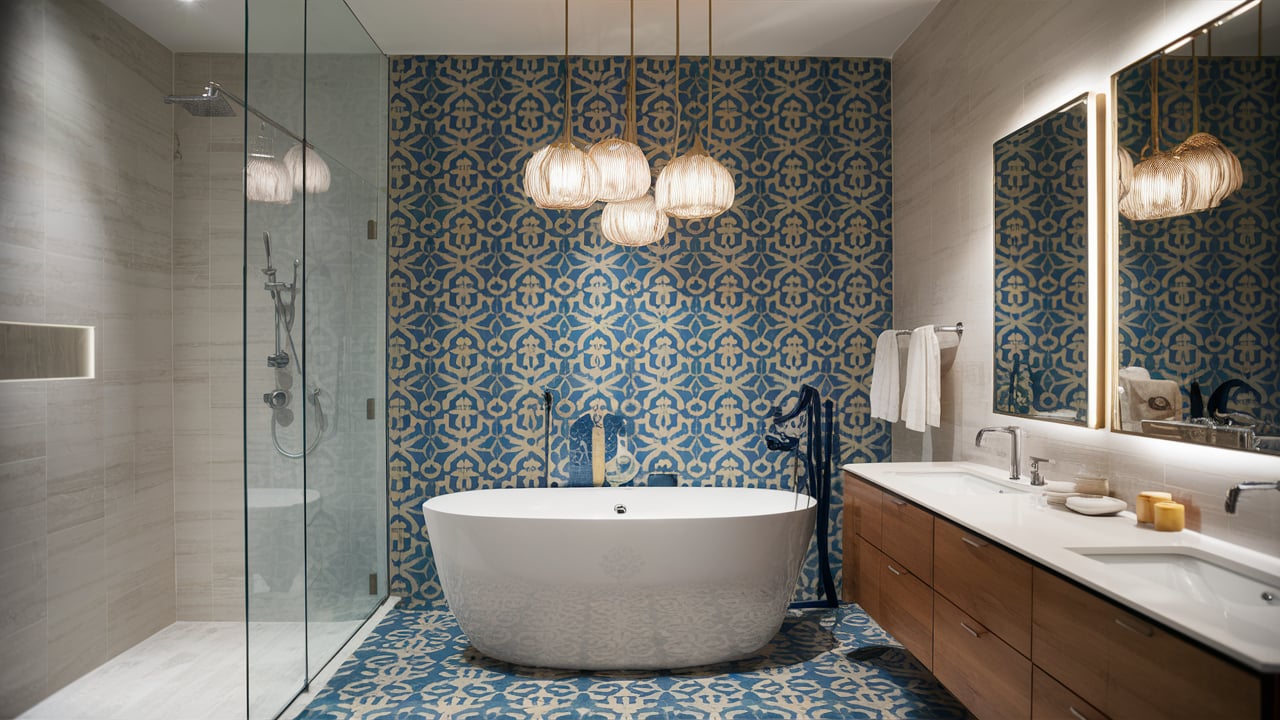
- Inspirational Design Ideas and Tips
Inspirational design ideas include using blue and white tiles as a backsplash, creating an accent wall, or incorporating mosaic patterns for a unique look.
Expert Opinions
- Insights from Interior Designers
Interior designers emphasize the importance of balance and proportion when using blue and white tiles. They recommend combining these tiles with neutral colors and natural materials to create a harmonious look.
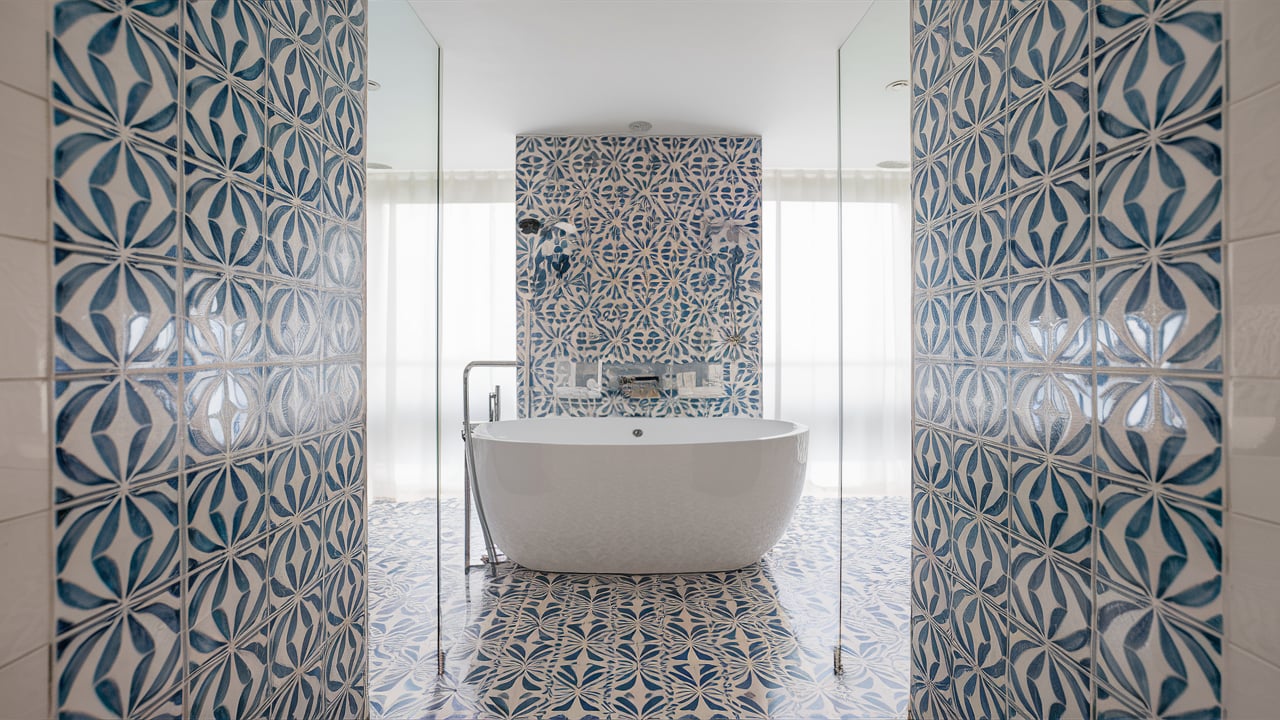
- Tips from Industry Experts
Industry experts suggest choosing high-quality tiles and hiring professional installers to ensure a flawless finish. They also recommend considering the overall design theme and how blue and white tiles will complement other elements in the bathroom.
Budget Planning
- Cost Breakdown of Materials and Installation
Budget planning is crucial for any renovation project. A cost breakdown of materials and installation will help you manage expenses and make informed decisions.
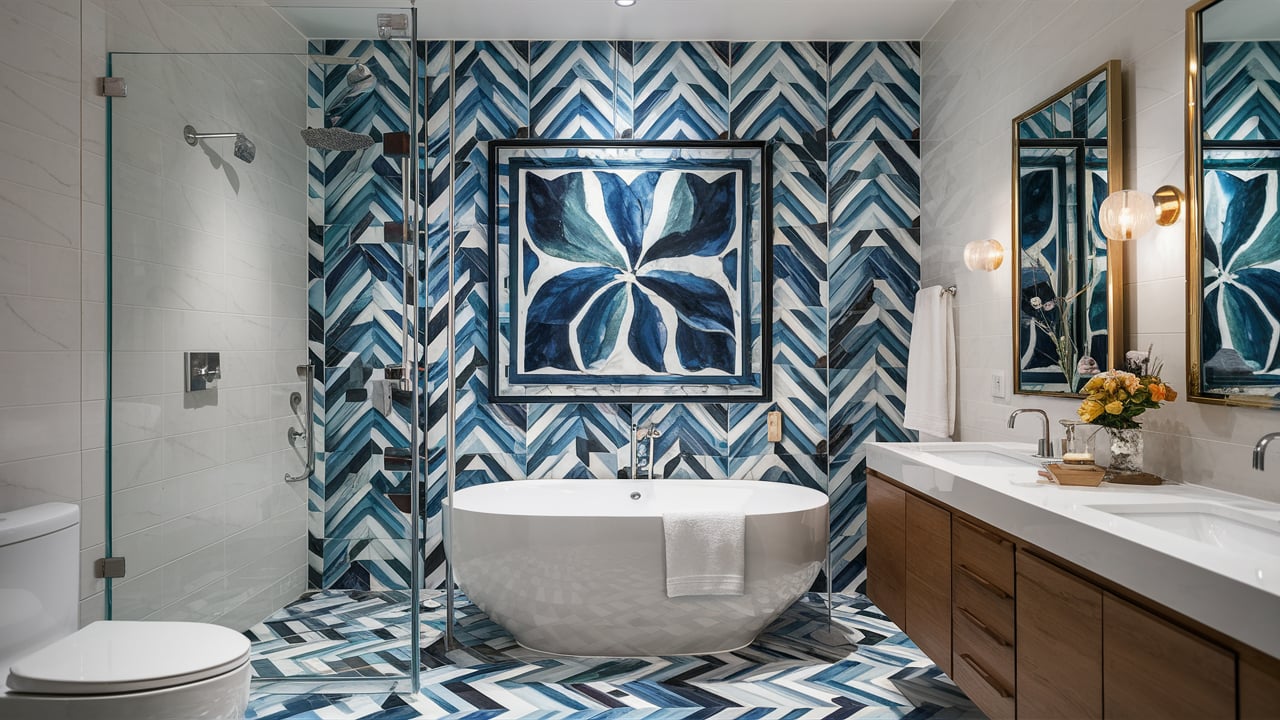
- Budget-Friendly Design Tips
Budget-friendly design tips include using ceramic tiles, which are more affordable than porcelain or natural stone, and focusing on accent areas rather than tiling entire walls.
- Value for Money Considerations
Investing in high-quality tiles may have a higher upfront cost but will provide long-term value due to their durability and timeless appeal.
Sustainability Considerations
- Eco-Friendly Tile Options
Eco-friendly tile options include recycled glass tiles and tiles made from sustainable materials. These options reduce the environmental impact of your renovation.
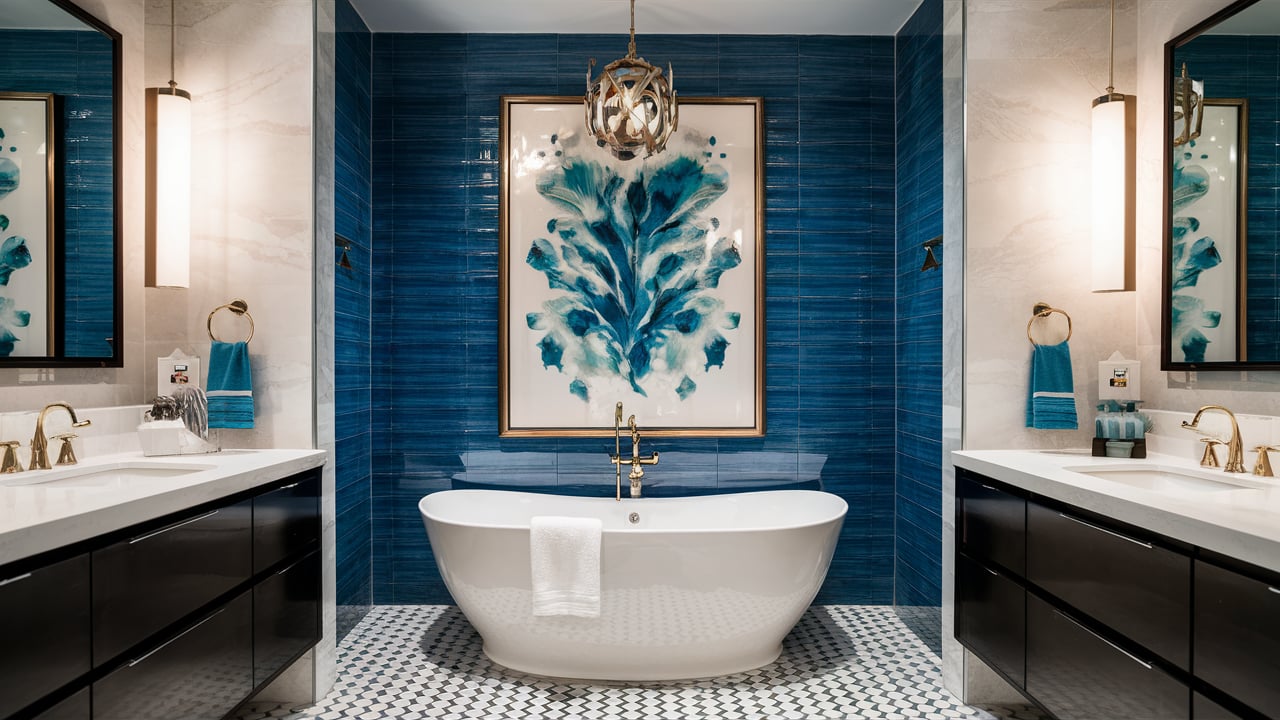
- Sustainable Design Practices
Sustainable design practices include using water-efficient fixtures and ensuring proper ventilation to reduce moisture and mold growth.
- Impact on the Environment
Choosing eco-friendly tiles and sustainable practices helps minimize the environmental impact of your bathroom renovation, contributing to a healthier planet.
Conclusion
- Summary of Key Points
Blue and white bathroom tiles offer a timeless and versatile design solution that can enhance the beauty and functionality of any bathroom. Their aesthetic appeal, durability, and cost-effectiveness make them a popular choice for homeowners and designers alike.
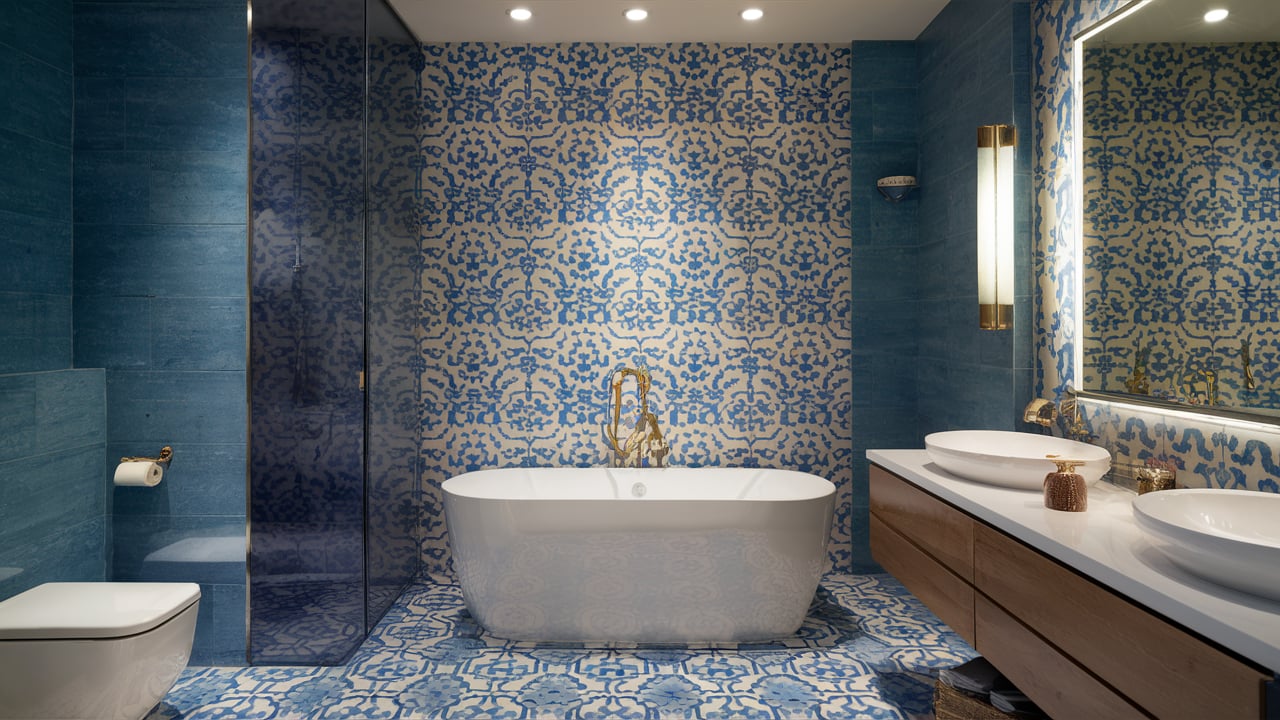
- Final Thoughts on Blue and White Bathroom Tiles
Whether you’re renovating an existing bathroom or designing a new one, blue and white tiles provide a classic yet contemporary option that can be tailored to suit any style. By considering the various types, design principles, and maintenance tips outlined in this guide, you can create a stunning and functional bathroom space that stands the test of time.
FAQs
Common Questions and Answers About Blue and White Bathroom Tiles
- Are blue and white tiles suitable for small bathrooms?
- Yes, blue and white tiles can make small bathrooms appear larger by reflecting light and creating a bright, airy feel.
- How do I clean blue and white tiles?
- Use a mild cleaning solution and a soft cloth or sponge. Avoid abrasive materials that can scratch the surface.
- Can I use blue and white tiles in a shower area?
- Yes, blue and white tiles are suitable for shower areas. Ensure proper sealing to prevent water damage and mold growth.
- What is the cost of blue and white bathroom tiles?
- The cost varies depending on the material and quality. Ceramic tiles are generally more affordable, while porcelain and natural stone are more expensive.
- How do I choose the right pattern for my bathroom?
- Consider the overall design theme and size of your bathroom. Geometric patterns and simple layouts work well in modern bathrooms, while intricate designs are suited for traditional spaces.
- Do blue and white tiles require special maintenance?
- Regular cleaning and sealing of grout lines are essential for maintaining the appearance and longevity of blue and white tiles.














